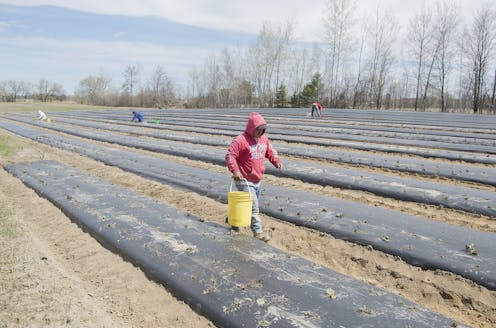
The government of Canada recently amended the Immigration and Refugee Protection Regulations to include new employer obligations. These amendments are intended to enhance protections for migrant workers and ensure the integrity of the government’s temporary foreign worker program.
While a step in the right direction, the changes side-step the root issues that make temporary foreign workers vulnerable to abuse in the first place.
More than 61,000 migrant workers were employed in Canada’s agriculture sector in 2021, an increase of almost 12 per cent from 2020, marking the greatest proliferation since 2016.
In fact, migrant workers comprised nearly one-quarter of all agricultural workers in 2021.
Migrant agricultural workers are exposed to various physical and psychosocial health risks that are compounded by the precarious circumstances they face in Canada.
Our research shows that the conditions of employment under Canada’s temporary foreign worker program generate significant challenges to workers’ health, the protection of their rights and even their survival.
Repatriated if injured, sick
Workers are hired on temporary contracts that bind them to a single employer, and these contracts include a repatriation clause that allows employers to terminate and deport workers without a grievance process. Injured and sick workers are often repatriated before they can access health care and/or workers’ compensation.
Consequently, migrant workers are often unable to refuse unsafe work and are reluctant to raise health concerns or report situations of abuse.
While acknowledging some of the issues facing migrant workers in Canada, the amendments to the Immigration and Refugee Protection Regulations fail to address the power imbalances at the heart of the temporary foreign worker program. In fact, they risk further cementing some of these systemic problems.
Employers as health mediators
First, the federal government continues to entrench the role of the employer as an informal mediator of basic health care for workers.
Migrant workers in Ontario are eligible for provincial health care, but they experience many barriers to accessing such services, in part because of a reliance on employers.
Under the new amendments, the government of Canada once again normalizes this role. Employers are obligated to cover the waiting period before provincial health care eligibility by providing private health insurance to migrant workers upon arrival.
By imbuing the responsibility of “reasonable access to health care services” to employers when a worker is injured or becomes ill at the workplace, the government is wilfully denying the power imbalance and obvious conflict of interest posed by such an arrangement.
Consider, for example, the history of medical repatriations faced by this workforce, in which injured and sick workers are prematurely deported. At minimum, workers need independent access to health care that is unmediated by employers.

Labour abuses
Second, the risk of labour abuses and exploitation are addressed only through paperwork, and again, delegated to employers.
To illustrate, the new amendments require all employers to provide migrant workers with an employment agreement on or before the first day of work, and they are to be drafted in English or French.
The agreements must match the initial offer of employment and include information about the job offer, wages, including overtime pay, and working conditions. Many migrant workers do not read English or French. Our research has also shown that workers’ rights on paper are almost never recognized in practice.
Therefore, there is no substitute for meaningful oversight and regulation.
More promisingly, the definition of “abuse” under the new amendments has been updated to include “reprisal.”
We support this definition, as we have previously advocated for this and other actions to address workers’ risk of reprisal.

Vulnerable worker permit
As has been the case since 2019, if a worker can prove they’re being abused, they may have access to an Open Work Permit for Vulnerable Workers.
However, that permit is an ineffective mechanism to report workplace abuse because it places the burden of proof on the worker. What’s more, it doesn’t guarantee future re-employment via the temporary foreign worker program, nor does it provide workers with the housing or support they require to find new employment.
To seriously respect the rights of migrant workers, Canada needs to transform the structure of the temporary foreign worker program to curtail the power and impunity of employers and embed rights and protections for workers.
This can only be done by providing truly structural changes, such as open work permits and permanent status — measures long called for by migrant workers and their allies.
To do any less is merely making cosmetic changes to a fundamentally flawed system.
Stephanie Mayell receives funding from the Social Sciences and Humanities Research Council (SSHRC). She is affiliated with the Migrant Worker Health Project, and the Migrant Worker Health Expert Working Group (MWHEWG).
C. Susana Caxaj receives funding from the Social Sciences and Humanities Research Council (SSHRC). She is affiliated with the Migrant Worker Health Expert Working Group
Janet McLaughlin receives funding from the Social Sciences and Humanities Research Council (SSHRC) and the Canadian Institutes of Health Research (CIHR). She is affiliated with the Migrant Worker Health Project and the Migrant Worker Health Expert Working Group (MWHEWG).

Leave a comment